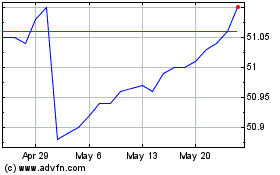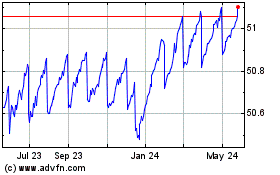With bond yields near record lows, and the losses are likely to
be very high if the yields go up, most of the fixed income products
offer poor returns and higher risk. This has resulted in some
investors looking to more volatile stocks for bigger chunks of
their portfolios.
In this backdrop of growing fears related to interest rate
hikes, investors continue to look for ways to hedge against
potentially rising interest rates. One such space that has seen a
great deal of interest is the floating rate securities market,
which provides safe income to investors with lower downside risk
(read: Time for Inverse Bond ETFs?).
What are Floating Rate Notes?
Floating rate notes (also known as floaters) are investment
grade bonds that do not pay fixed rate to investors but instead
have variable coupon rates that are often tied to an underlying
index (such as LIBOR) plus a variable spread depending on the
credit risk of the issuers.
As such, these securities have far lower interest rate
sensitivity than their fixed rate counterparts, making them ideal
choices in rising interest environments (see Floating Rate Bond ETF
Investing 101).
While these bonds usually go a long way in reducing interest
rate risk, they still are subject to the credit risk of the issuer.
Therefore, if the issuers go belly up, bond holders face the risk
of losing their invested capital.
The coupons associated with these bonds are generally lower that
most traditional fixed income securities. Moreover, while these
bonds prevent losses, the flip side also holds true—these even
restrict the upside (read: Junk Bond ETF Investing: Is It Too
Late?).
However, given the current economic conditions and rock-bottom
interest rates, investors could be better off playing the floating
rate bond portfolio with minimal duration risk than the more
traditional bond segment.
Floating Rate ETFs in Focus
While in the near term, floating rate bonds might underperform
similar fixed securities, they could nicely complement the fixed
rate-heavy portfolios of investors with more than a few years until
retirement. For these investors, any of the following three ETFs
could make for an excellent choice:
iShares Floating Rate Note Fund
(FLOT)
Launched in June 2011, FLOT seeks to match the price and yield
of the Barclays US Floating Rate Note less than 5 Years Index,
before fees and expenses. The index comprises floating rate notes
issued by various institutions.
The notes in the index are investment grade and have a residual
maturity ranging from a month to five years. The variable coupon
for the notes in the index is equal to an aggregate of 1/3/6 months
LIBOR rate (i.e. reference rate) plus a variable spread depending
on the credit risk of the issuers.
The fund has a lower default risk with a weighted average
maturity of 1.66 years and presently holds 277 notes issued by
various institutions. It pays out a dividend yield of 0.65% per
annum and has added 0.12% year-to-date (read: 3 High Yield ETFs for
Your IRA).
As far as credit risk is concerned, the ETF can be considered a
relatively safe option for investors as the fund gets an overall
credit rating of A+ by the S&P. This implies that the ETF has a
strong capacity to meet financial commitments, but is somewhat
susceptible to adverse economic conditions and changes in
circumstances.
Also, an effective duration of 0.14 years signifies negligible
vulnerability to interest rate risk thanks to the resetting of
LIBOR. The ETF charges a paltry 20 bps in fees per year from
investors and is the most popular fund in the space. It has
witnessed an impressive inflow of over $1.1 billion so far this
year, pushing its asset base to $1.5 billion.
SPDR Barclays Capital Investment Grade Floating Rate ETF
(FLRN)
This ETF seeks to replicate the performance of Barclays Capital
U.S. Dollar Floating Rate Note less than 5 Years Index. The Index
measures the performance of floating rate notes which are U.S.
dollar denominated and uses the 3-month LIBOR as the reference
rate.
The ETF debuted in December of 2011 and since then has managed
to attract a moderate asset base of $24.4 million. The weighted
average maturity and an effective duration of the ETF are 1.60
years and 0.13 years, respectively.
FLRN holds 142 securities and charges just 15 basis points in
fees and expenses. The ETF lacks popularity as indicated by an
average daily volume of 10,000 shares (see more in the Zacks ETF
Center).
The product has an average yield of 1.04%, making it one of the
best in the space in terms of yields. It has gained 0.49% so far
this year, and has been a low volatility choice.
Market Vectors Investment Grade Floating Rate ETF
(FLTR)
This fund tracks the Market Vectors Investment Grade Floating
Rate Bond Index which measures the performance of investment rate
floating rate bonds that are issued by U.S. firms as well as global
corporates.
Launched in April of 2011, the product has amassed $15 million
in AUM while charging investors 19 bps in annual fees. However, it
has a wide bid/ask spread as it trades in paltry volumes of roughly
18,000 shares per day, thereby increasing the total cost for the
product.
With holdings of 51 securities, FLTR has comparatively
high-weighted average maturity of 2.29 years and average modified
duration of 2.24 years. Therefore, it is more sensitive to interest
rate movements than most of its counterparts.
The ETF is currently sporting a yield of 0.77% and has added
1.09% in the year-to-date time frame.
Want the latest recommendations from Zacks Investment Research?
Today, you can download 7 Best Stocks for the Next 30
Days. Click to get this free report >>
ISHARS-FL RT NT (FLOT): ETF Research Reports
SPDR-BC IG FR (FLRN): ETF Research Reports
MKT VEC-IG FRB (FLTR): ETF Research Reports
To read this article on Zacks.com click here.
Zacks Investment Research
Want the latest recommendations from Zacks Investment Research?
Today, you can download 7 Best Stocks for the Next 30 Days. Click
to get this free report
iShares Floating Rate Bo... (AMEX:FLOT)
Historical Stock Chart
From Dec 2024 to Jan 2025

iShares Floating Rate Bo... (AMEX:FLOT)
Historical Stock Chart
From Jan 2024 to Jan 2025
